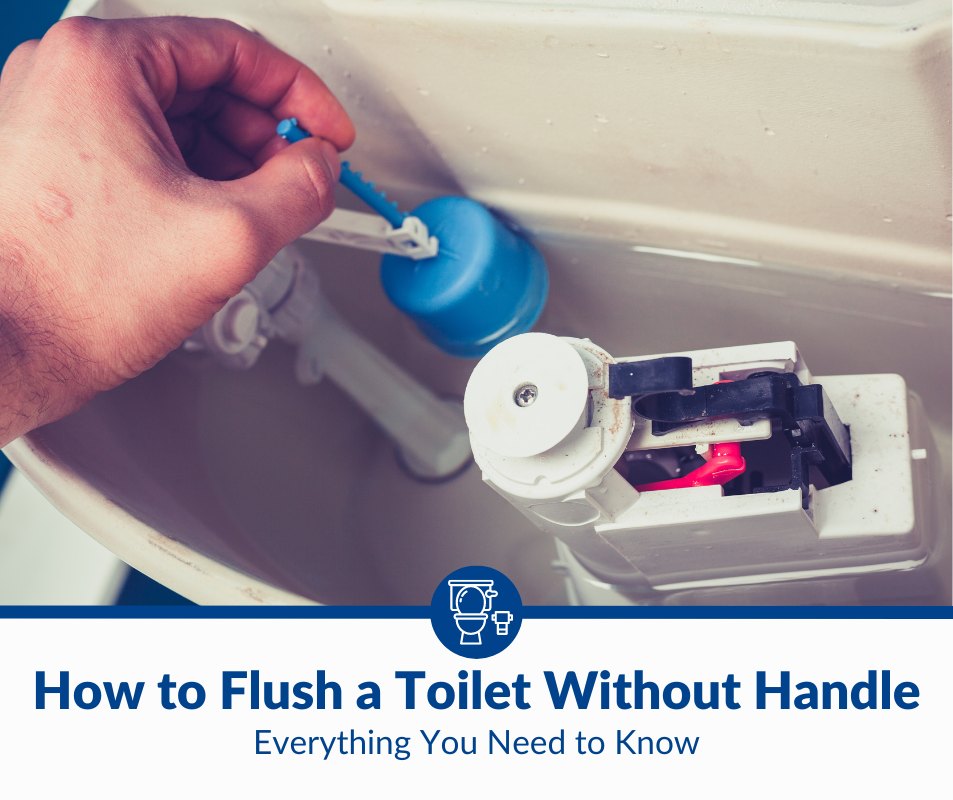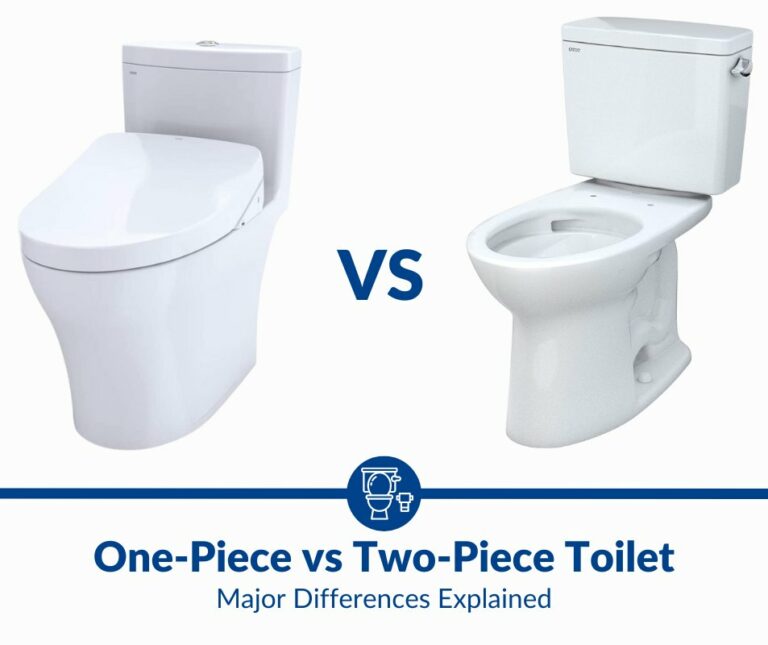How To Flush a Toilet Without a Handle
Toilet handles are not the strongest metal on earth, and they can break from time to time. This is a fairly common plumbing issue – toilet handles break in many homes when the toilet has been used for a long time and when someone applies too much force on the handle. When that happens, there are temporary and permanent solutions to get your fixture back up and running in no time.
You can flush a toilet without a handle by removing the cistern/tank lid, locating the toilet lift chain, and pulling it. Or, simply reach down to the bottom of the tank, locate the flapper (usually attached to the tank by a chain), and flip it open to let the water drain into the toilet bowl.
In this article, we’ll go over the common reasons why toilet handles break, how to prevent that from happening, and how to flush your toilet without a handle.
Causes of a Broken Toilet Handle
Toilet handles are made of a wide range of materials such as plastic, zinc, and brass, and in some toilets, stainless steel is used for the handle. When a toilet handle breaks, it can happen unexpectedly or over time. The lever becomes loose and doesn’t whenever you pull or push the lever to flush your toilet.
Below are the causes of a broken toilet handle:
- Substandard toilet handles – Some handles are made of low-quality materials to minimize production costs. These handles easily snap at high-stress points – you almost always guarantee this is the issue when your handles always seem to break at the same point.
- Poor installation – When the handle is poorly installed, it’s bound to break. The lever should be properly aligned with the tank and not tilted at an angle. When pressure is applied on a misaligned handle, it could break at the weak point. The lift chain length should also be appropriate – an extremely short chain could exert more force on the handle.
- Exerting too much force when flushing – It is advisable to apply little force on the lever. Some toilets will require more force. However, this may weaken the plastic arm and put more stress on the handle at its weakest point.
- Old handle – Toilets can last between 10 and 30 years with proper maintenance. With time, rust weakens the integrity of the metallic handles. Dirt and salts (for people living in areas with hard water) accumulate on the handle’s moving parts, making it harder to flush with little effort.
Sometimes, the toilet handle may not be broken but just loose. If that’s the case, locate the plastic or metal nut and washer behind the tank and tighten them lightly.
Temporary Fixes for a Broken Toilet Handle
Before we discuss fixing a toilet handle, it helps to point out several types of handles based on their working mechanism and their mount location on the toilet tank. Examples of handles based on their working mechanism include:
- The traditional handle
- Push button
- Wall flush plate
Toilet handle examples based on their location on the tank include:
- Front tank lever
- Side tank lever
- Angle mount lever
- Universal toilet flush lever
A broken toilet handle will not put up any resistance when flushing your toilet. The good news is that there are a few temporary solutions to the problem:
1. Gently Pull on the Lift Chain To Flush the Toilet
The lift chain connects the flush lever to the flapper. This chain is usually left intact when the toilet lever or arm breaks. However, you still have to lift the tank lid, reach out for the lift chain, and gently pull it up every time you flush the toilet. Lifting this chain lifts the flapper, allowing water to flow into the toilet bowl.
2. Makeshift Keyring and Zip Tie Handle
A makeshift zip tie handle is a quick temporary solution that takes minutes. Attach one zip tie to the flapper and push another zip tie through the hole in the tank. To keep the zip tie handle from falling back inside, you can attach a key ring or anything you like.
3. Dental Floss and Stick Handle
You can fashion a quick handle from dental floss and a stick in minutes.
- Turn off the water and locate the flapper.
- Attach one end of the dental floss to the flapper and push the other end of the string through the hole in the tank. Tie this other end to a stick, and voila! A temporary lever that’s guaranteed to get the job done.
Caution: Most of the temporary fixes highlighted above should not be expected to last more than a few days. In case they fail to work, consider replacing the handle immediately.
Permanent Fixes for a Broken Toilet Handle
If temporary fixes don’t cut it, there are several ways to fix the problem in the long run. For one, you could replace the entire handle. This is an easy DIY project that takes minutes. If that does not work, you could replace the entire flushing mechanism.
1. Replace the Handle
You can find replacement parts for your broken toilet handle at your nearest hardware store. But before making your purchase, be sure to inspect your toilet and take note of the broken handle. You may as well take out the broken handle and take it to the store as a sample.
That said, here’s how to replace a broken toilet handle:
- Open the tank lid to gain access to the tank.
- Shut off the water supply to your toilet and flush it. If you haven’t installed a temporary flush mechanism, reach down for the flapper and flip it open. This will clear out the water and give you some room to work in.
- Unhook the lift chain from the flapper and the flush arm. Take note of the hole in which the lift chain goes on the flush arm.
- Twist the plastic nut behind the flush lever and avoid putting too much force. If possible, unwind the nut by hand.
- Unwrap your new toilet handle and push it into place. Lock it into position by turning the provided nut by hand until it touches the base of the handle.
- Reattach one end of the lift chain onto the same hole on the arm and the other on the flapper.
- Turn the water back on and try the new handle.
Sometimes, you may need to switch the lift chain between the holes on the toilet arm to adjust the tension on the chain.
2. Replace the Entire Flushing Mechanism
Although not common, the flushing mechanism could be jammed. In this case, the flush valve assembly is the probable cause, and replacing it with the toilet handle is much easier than you might think. All you need is a few basic tools and a new flushing mechanism.
- Start by shutting off the water supply to your toilet and flushing it, so the tank is empty.
- Use a dry sponge to clear out the residual water. Then, remove the toilet tank lid and unscrew the flush handle.
- Remove the flush handle from the toilet tank and the flush arm. You’ll need to unscrew the plastic nut and pull the handle off the tank.
- Unmount the toilet’s mounting bolts and uninstall the tank. Flip it upside down to reveal the rubber/sponge gasket at the bottom of the tank. After removing the gasket, you should see a lock nut.
- Unscrew the lock nut from the tank to remove the flush valve assembly. Take note of the overflow tube’s position.
- Insert the new flush valve, followed by the rubber seal, and hold it in place with its new lock nut. Cover the lock nut with a new sponge gasket.
- Install the flapper attached to the arm by the lift chain.
- Mount the tank to the toilet bowl and secure it with the mounting bolts.
- Reconnect the water and flush your toilet.
Watch this video for more detailed instructions on replacing the flush mechanism:
Damaged or worn-out flush valve assemblies should be replaced, along with new mounting bolts. That’s because it is often difficult to pinpoint the cause of the problem since the valve has many moving parts.
Regardless, you should always consider getting a professional plumber for the job. Certified plumbers have the right tools and experience to fix your toilet handle so that it serves for decades.
Prevention of a Broken Toilet Handle
Prevention is better than cure, especially regarding plumbing. Routine maintenance, inspections, and early repairs are a solid way to keep your toilet intact for years to come. That said, here’s how to prevent toilet handles from breaking;
1. Clean the Lever, and the Entire Toilet
Limescale buildup can stiffen the toilet flush lever over the years. As such, more force would be required to flush the toilet. A simple cleaning routine can help loosen up the moving parts. You only need to pour a few cups of vinegar into your toilet and let it sit for a few hours before rinsing it with clean water.
2. Inspect and Maintain Your Toilet Regularly
Periodic inspections can never be understated. Your toilet has several moving parts that must be checked at least once a year. Common things to check include the following:
- The plastic nut holding the lever to the arm.
- Rust or limescale buildup on the handle.
- Inspect for leaks – Over time, rubber stoppers, joints, washers, and pipes wear and start leaking. At first, tiny leaks may not pose an immediate danger, but as they grow larger, they may lead to mold infestations, health hazards, slippery floors, and costly repairs. As such, they must be fixed in time.
When you pull or push the lever, it should offer some resistance as it tries to restore its original position.
3. Buy From Original Manufacturers or Trusted Sellers
Toilet handles often break due to cheap components. We recommend buying replacement parts from trustworthy sellers. Although they may not last a lifetime, higher-quality parts will serve longer than cheap ones.
Conclusion
In summary, here’s what you need to do to flush your toilet without a handle:
- Remove the lid and reach for the lift chain or flapper.
- Make a temporary handle from a keyring and zip ties.
- Use dental floss tied to a stick as a temporary handle.
- Replace the handle.
- Replace the entire flush mechanism.
Broken handles are a frustrating inconvenience. Thankfully, you can avoid frustration by learning to flush your toilet without a handle for a few days. Even better, it would help to take preventive measures to keep your handle from breaking when needed.
Do you have any stories, tips, or toilet handle replacement alternatives you’d like to share? Let us know in the comments!







